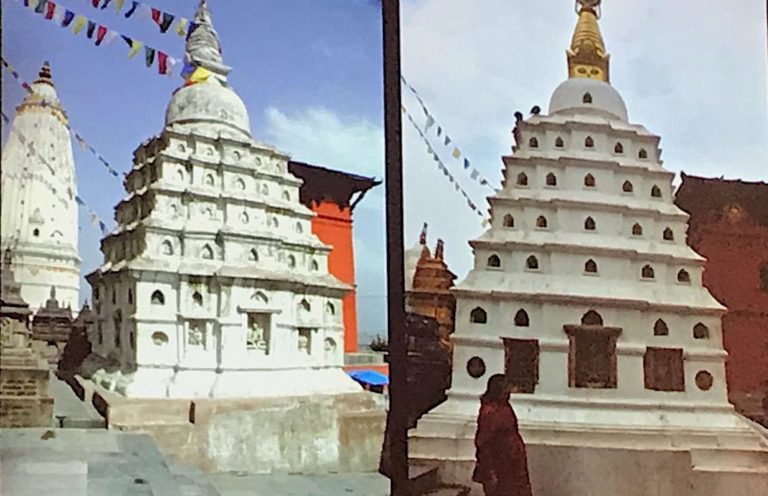
Mangal Bahdvar Caitya (Tashi Gomang).
Before the earthquake and after reconstruction.
© David Andolfatto.

Buildings damaged by the earthquake and still not
demolished or reconstructed in Kathmandu.
© Brigitte Steinmann.
On 22 November SEECHAC hosted a round table discussion entitled “The reconstruction of monuments and communities in Nepal after the earthquake of 2015.†The discussion, which was held at the Maison de l’Asie, avenue du Président Wilson, relvoved around four presentations on different aspects of the aftermath.
The first of the presentations was given by David Andolfatto (Sorbonne University), who considered a case study in the context of a UNESCO project that included archaeological excavation and reconstruction of an 18th-19th century stupa located in Svayambhu, in the Kathmandu Valley. This example showed that different scientific discoveries could be made following the disaster and demonstrated the importance of scientific (archaeological, historical, structural, etc.) research. Deficiencies were then noted in relation to the UNESCO project and other initiatives. These problems were due mainly to inappropriate choices of materials and the lack of qualified manpower.
Brigitte Steinmann (University of Lille, CNRS) emphasised that the earthquake had not only caused lasting trauma, but had also revealed and accentuated significant social rifts. Some examples of areas of investigation and interventions between 2015 and 2019 in the Kathmandu Valley and the regions of Doramba, Ramechap, Rasuwa and Langtang, offer illustrations of how the choices of reconstructions of schools and religious buildings, in particular, reveal the deep inequalities between measures implemented by the state on the one hand and private associations on the other. The growth of urban capitalist land policies thrives on the disaster thanks to debt and usury, and has led to the poorest populations being all but abandoned.
Michael Hutt (SOAS, London), the third speaker, began by assessing the applicability of the “critical juncture vs accelerated status quo†model of disaster aftermaths (Pelling and Dill [2010]) to the earthquake of 2015. He then went on to describe the way in which the Dharahara tower, a 19th-century structure in central Kathmandu, came to serve as an icon for the disaster and the country’s determination to rebuild, and summarised the recurrent themes of the large corpus of earthquake-related Nepali-language poetry published within three months of the earthquake.
Following an introductory assessment of the extent of the destruction and the state of reconstruction from national data and architectural para-seismic models produced by the National Authority of Reconstruction, Blandine Ripert (CNRS) and Denis Blamont (CNRS) presented the diversity of situations in the field on the borders between Nuwakot, Dhading and Rasuwa districts, based on examples from 8 villages (3,000 houses). The variation in the extent of destruction could be explained by soil geomorphology, stone quality, availability of materials and construction techniques, that differ greatly from place to place. The progress of reconstruction also varies from one village to another depending on the constraints – natural, economic, political – faced by villagers trying to rebuild their communities. The rebuilt housing displays striking homogeneity following the standards imposed by the NRA, which is poorly adapted to local practices and which significantly alters the organization of domestic space. This raises questions concerning the timing and quality of government communication, which is prescriptive rather than informative; of the adequacy of the institutional response to local needs; of the competence of the actors on the ground, and the difficult collaboration between the state and the local administration, NGOs and the people.




